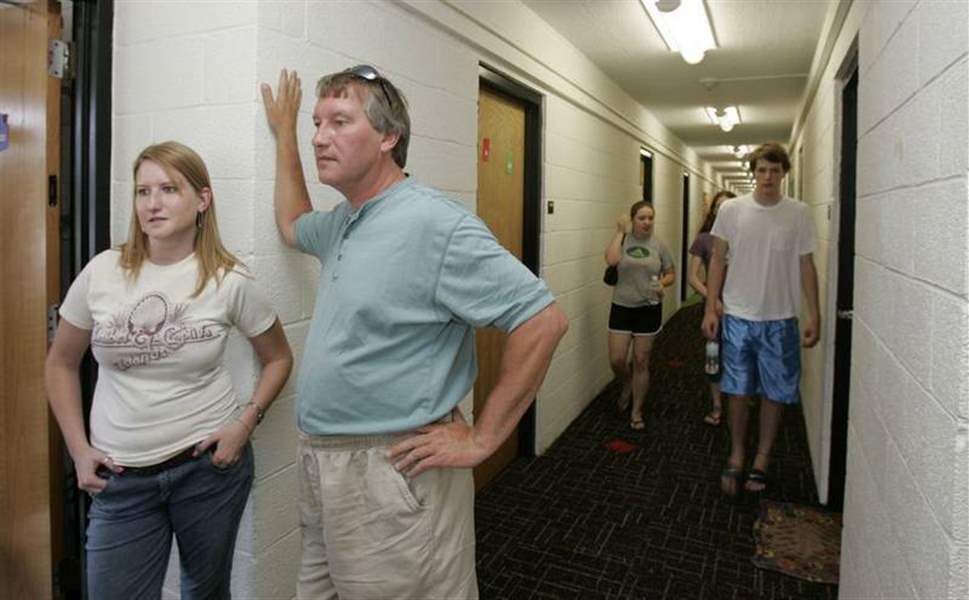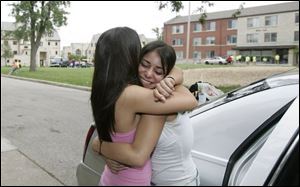
Toledo-area campuses add security measures
8/19/2007
Kristina Karbula, 19, and her father, Mick Karbula of Lexington, Ohio, discuss security features near Ms. Karbula's new dorm room in Dowd Hall at the University of Toledo. 'I was really impressed with the safety here,' Ms. Karbula said.

Kristina Karbula, 19, and her father, Mick Karbula of Lexington, Ohio, discuss security features near Ms. Karbula's new dorm room in Dowd Hall at the University of Toledo. 'I was really impressed with the safety here,' Ms. Karbula said.
If a gunman walked onto a college campus and opened fire, local students could soon be alerted to such a crisis just by answering their cell phones or checking their e-mails.
In the wake of a massacre late last school year at Virginia Tech, most area colleges and universities are seeking ways to better communicate with students during emergencies.
While students were away on summer break, college leaders were meeting across the state and working to put new notification systems and updated emergency plans into place.
"In our culture, in our nation this year, we've experienced horrific levels of emergencies. But there are small things as well," said Robin Bowlus, spokesman for Bluffton University in Bluffton, Ohio. "Virginia Tech is probably not going to happen on my campus, but you need to be prepared for any version that could happen."
On April 16, Seung-Hui Cho shot 32 people and then himself on the Blacksburg, Va., campus.
The tragedy affected the nation, and locally, Ohio Gov. Ted
Strickland responded by having the Ohio Board of Regents create a task force for the state's higher education institutions to determine whether they would be prepared to respond to a similar incident or other emergencies.
"We knew when we started that every school was taking this issue seriously," Chancellor Eric Fingerhut said. "What our approach has been is to try to make sure we all understand what best practices are, learn from each other's lessons, [and] try to help each other raise standards of safety and security."

Sisters Angelina and Noelle Vinciguerra will be apart as Angelina begins her first year at UT.
Since the governor created it, the Campus Security Task Force has convened as a whole group twice through teleconference sites set up across the state, one of which was at Bowling Green State University. Four smaller work groups met together in Columbus several times and focused on prevention, response, communications, and resources.
As students return to college campuses tomorrow and through upcoming weeks, safety is on everyone's mind.
Mick Karbula helped his daughter - his first child to go away to college - move into her new residence hall at the University of Toledo last week.
He said he appreciates the university's efforts to protect his daughter. And living about three hours away, he likes knowing there are things such as security cameras in her residence hall.
"That makes me feel safe," he said.
His daughter, Kristina Karbula, is already knowledgeable about campus safety.
The 19-year-old from Lexington, Ohio, transferred from North Central State College, where she was on the safety committee as president of student government.
There, she said, the college was just starting to put emergency phones on campus. UT has had those on its grounds since the mid-1980s and in 2005 updated the more than 70 outdoor units that call campus police with the touch of a button.
"I was really impressed with the safety here," Ms. Karbula said while moving into her residence hall in Dowd Hall.
UT also has stepped up campuswide security by ordering rifles and organizing training for its force of about 30 campus police officers.
In addition, the university has received a new mobile command unit and is implementing an electronic notification system that would quickly alert students and staff if a problem arose on campus, police Chief Jeff Newton said.
"There's definitely unique issues for college police departments," he said, noting the number of people who live on campus, that some students are unfamiliar with the area, and that they are at an experimental age.
Still, he said, "on campus is much safer still than off."
Chief Newton represented the university on the statewide task force dedicated to evaluating security measures in the wake of the Virginia Tech tragedy.
One lesson that everyone learned after it was the challenges of disseminating information on campus, reaching parents of students as well as the nearby community, and communicating accurate information to the media.
"The crisis situations are all about communication and it's a very difficult process," Ms. Bowlus said.
The nearly 1,200-student Bluffton University, which is in a rural community, had first-hand experience with the challenges of communicating a devastating event to the campus and national media. In March, a bus carrying the school's baseball team to spring-break games in Florida crashed in Atlanta, killing five players, the bus driver, and his wife.
The school's Web site was down for days because people flooded it looking for information.
The site now has a new server, Ms. Bowlus said.
But Bluffton has an unusual situation in which almost all students live on campus, so reaching them by e-mail and residence hall staff is quite effective, she said.
Others with larger campuses, including the University of Findlay, which has more than 4,500 students, have turned to new technology to quickly get information to everyone.
The university recently bought and is installing a system called Lynx that can instantly send text messages to cell phones and pop-up messages to campus computers in the event of an emergency. It should be in place this semester, said Matt Bruskotter, program manager for the School of Environmental and Emergency Management.
The system can send voicemail or text messages to the cell phones of students who choose to register their numbers with the university. All new students can opt in.
And most rooms on campus have a computer in them, making the pop-up warning messages an easy way to reach out, Mr. Bruskotter said.
"This pop-up will supersede anything that's on that screen," he said.
"It will give the day, the time, and this is what's going on. And along with that pop-up, we can attach directions they should follow."
Aside from technology, the university also has a large speaker in the bell tower that can be heard across campus, Mr. Bruskotter said.
UT has signed a contract with a similar provider called Red Alert that would send text messages and e-mails - thousands of people can be reached every 30 seconds - in the event of an emergency, Chief Newton said.
Both universities had started looking into that type of system before the Virginia Tech shootings.
Bowling Green State University is planning to purchase a similar alert system.
Owens Community College had a test of its ability to notify students when a double shooting took place at a trucking company near its Perrysburg Township campus on Aug. 8. The gunman fatally shot two people at the business and then fled, prompting the college to send an alert, "Shooting NEAR the Toledo Campus," through its "Ozone" e-mail account.
"That was really more public service because we were worried about people's safety and want to make sure they know something of that caliber is going on," said Julee Cope, the college's chief of safety and security.
"We try to put out as much information as we can without creating a panic."
While Michigan didn't create a formal task force to explore campus safety issues, the Virginia Tech incident prompted schools in that state to probe their emergency response systems as well.
At Monroe County Community College, the administration sent out information to students and staff the day after the Virginia tragedy reminding them of safety features.
Those include a PA system, emergency phones, and surveillance cameras on campus, and two-way radios in areas such as the library that feed into a switchboard that is monitored at all times, college spokesman Joe Verkennes said.
Over the summer, officials evaluated those systems and discussed other possible upgrades.
At BGSU, officials sent out a similar letter last week to students, faculty, and staff letting them know what the college has worked on in the months since the Virginia Tech shooting.
The letter spelled out ways BGSU would communicate an emergency - e-mail, the university Web site, through speaker systems on campus police patrol cars, and campus and area media - and asked for everyone's help in thinking about safety first.
The beginning of the school year is the best time to communicate such information because of the new students and faculty arriving on campus, said Jill Carr, assistant vice present for student affairs and dean of students at BGSU.
"It's not a message that we're unsafe, it's just we need everybody to be a part of keeping the campus as safe as possible," she said.
The work of the statewide task force is wrapping up as the school year gets under way. It continues to look into long-term safety strategies and will meet one more time this month.
Involved colleges and universities are now filling out a safety checklist which is due to the Board of Regents by Friday.
The checklist includes eight questions, such as if campus and city police would respond together to an incident. The schools are to answer either "yes" or "need assistance."
State agencies are available to help colleges update their systems so they can answer "yes" to every question, Chancellor Fingerhut said.
"No is not an acceptable answer," he said. "We want to clearly send the message this is not stuff schools have to do on their own."
Mr. Fingerhut will report the work of the task force to the governor at the end of the month.
Contact Meghan Gilbert at:
mgilbert@theblade.com
or 419-724-6134.d